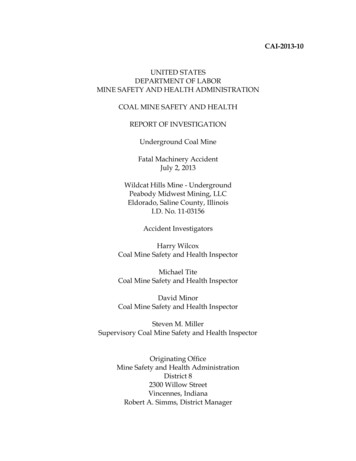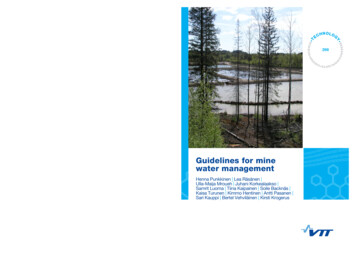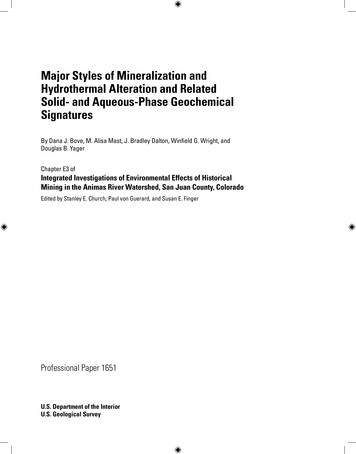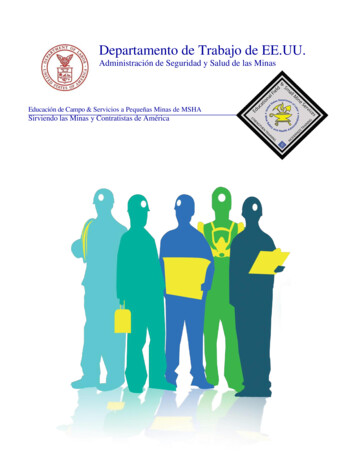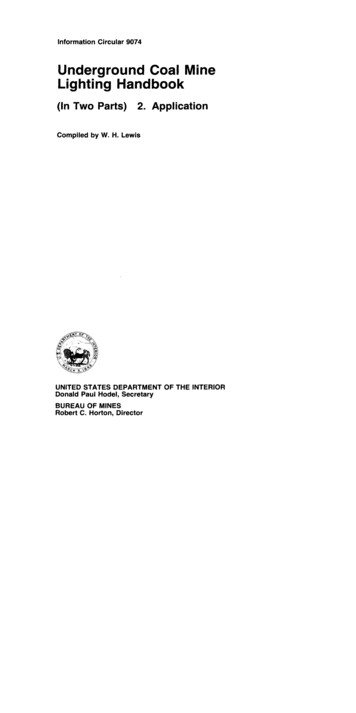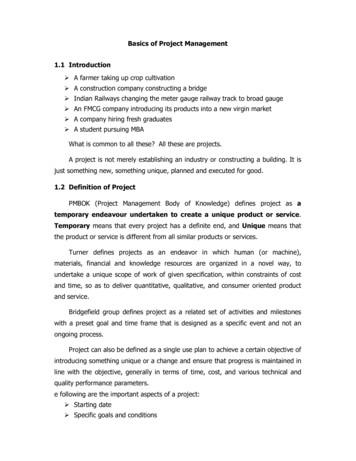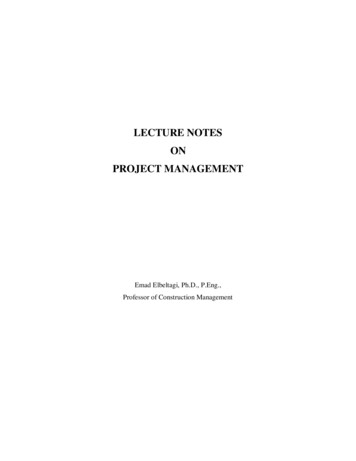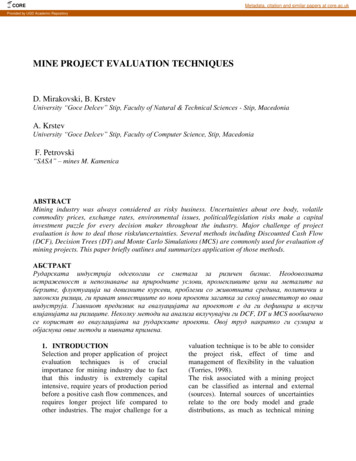
Transcription
COREMetadata, citation and similar papers at core.ac.ukProvided by UGD Academic RepositoryMINE PROJECT EVALUATION TECHNIQUESD. Mirakovski, B. KrstevUniversity “Goce Delcev” Stip, Faculty of Natural & Technical Sciences - Stip, MacedoniaA. KrstevUniversity “Goce Delcev” Stip, Faculty of Computer Science, Stip, MacedoniaF. Petrovski“SASA” – mines M. KamenicaABSTRACTMining industry was always considered as risky business. Uncertainties about ore body, volatilecommodity prices, exchange rates, environmental issues, political/legislation risks make a capitalinvestment puzzle for every decision maker throughout the industry. Major challenge of projectevaluation is how to deal those risks/uncertainties. Several methods including Discounted Cash Flow(DCF), Decision Trees (DT) and Monte Carlo Simulations (MCS) are commonly used for evaluation ofmining projects. This paper briefly outlines and summarizes application of those methods.АБСТРАКТРударската индустрија одсекогаш се сметала за ризичен бизнис. Неодовoлнатаистраженосст и непознавање на природните услови, променливите цени на металите наберзите, флуктуација на девизните курсеви, проблеми со животната средина, политички изаконски ризици, ги прават инвестциите во нови проекти загатка за секој инвеститор во овааиндуструја. Главниот предизвик на евалуацијата на проектот е да ги дефинира и вклучивлијанијата на ризиците. Неколку методи на анализа вклучувајчи ги DCF, DT и MCS вообиаченосе користат во еваулацијата на рударските проекти. Овој труд накратко ги сумира иобјаснува овие методи и нивната примена.1. INTRODUCTIONSelection and proper application of projectevaluation techniques is of crucialimportance for mining industry due to factthat this industry is extremely capitalintensive, require years of production periodbefore a positive cash flow commences, andrequires longer project life compared toother industries. The major challenge for avaluation technique is to be able to considerthe project risk, effect of time andmanagement of flexibility in the valuation(Torries, 1998).The risk associated with a mining projectcan be classified as internal and external(sources). Internal sources of uncertaintiesrelate to the ore body model and gradedistributions, as much as technical mining
specifications (ground condition, equipmentcapacities, workforce and management). Theexternal sources consist of commodity s, legislation and governmentpolicy.According to the results of a CanadianMineral Economics Society survey, whererespondents were asked to rank a list ofmining project risks, the highest risk comesfrom mineral reserves and ore grade, thenpolitical, social and environmental, metalprice, profitability/operating cost, location,capital cost, management and so on (Smith,2002). Lilford and Minnitt (2005) studiedproject valuation methodologies for mineraldeposits. At the end of the study, it wasconcluded that the selection of the valuationmethodology depends on the ability tocorrectly interpret all of the availableinformation and fundamental factors(commodity prices, exchange rate, ve transactions, uncertainty risk)required for each valuation methodology inorder to guide selection process.The purpose of this paper is to presentavailable mine project evaluation methodsand more specifically Discounted Cash Flow(DCF), Decision Trees (DT) and MonteCarlo Simulations (MCS) and subsequentlyapply them to a mine project using differentdiscount rates. The example of DCF methodis also presented stressing knowledge aboutthe input parameters and handling the timevalue of money concept.2. MINE PROJECT EVALUATIONMETHODS2.1 Discounted Cash-Flow analysisOne of the most common methods toevaluate a mining project is the DCFmethod. In 1995, Bhappu and Guzmansurveyed 20 mining companies located inthe USA, Canada, Mexico, Australia, andGreat Britain and obtained the results shownin Table 1(Bhappu and Guzman, 1995).Table 1. Priorities of 20 selected miningcompanies for investment 1131Paybackperiod362Othermethods300DCF is a valuation method used to estimatethe attractiveness of an investmentopportunity through future free cash flowprojections and discounts them (most oftenusing the weighted average cost of capital)to arrive at a present value, which is used toevaluate the potential for investment. If thevalue arrived at through DCF analysis ishigher than the current cost of theinvestment, the opportunity may be a goodone.where: CF – projected cash flowr- discount rateThere are many variations when it comes towhat you can use for your cash flows anddiscount rate in a DCF analysis.This method include the effects of risk andtime by adjusting or discounting the projectnet cash flow. The greater the projects risk,the higher the discount rate should be. Underthis method, Net Present Value (NPV) andInternal Rate of Return (IRR) are the mostcommon methods for evaluating a miningproject.Net Present Value (NPV)It is the difference between the present valueof cash inflows and the present value of cashoutflows. NPV analysis is sensitive to thereliability of future cash inflows that aninvestment or project will yield.PVn FVn/(1 interest)nwhere:
PVn - present value for year nFVn - future value for year ninterest – interest rate used for discountingIn addition to the formula, net present valuecan often be calculated using tables, andspreadsheets such as Microsoft Excel. If theNPV of a prospective project is positive, itshould be accepted. However, if NPV isnegative, the project should probably berejected because cash flows will also benegative.Internal Rate of Return (IRR)The discount rate often used in capitalbudgeting that makes the net present value ofall cash flows from a particular project equalto zero. Generally speaking, the higher aproject's internal rate of return, the moredesirable it is to undertake the project. Assuch, IRR can be used to rank severalprospective projects a firm is considering.Assuming all other factors are equal among2.2 The Decision Tree (DT) methodDecision Tree analysis is a method whichcomes from operations research and gametheory. The method estimates the probabilityof possible outcomes of a project bygenerating appropriate decision branches thathave probabilities of their likelihood ofoccurrence. It is simply a flowchart or diagramrepresenting a classification of a system or aprobabilistic model (Clemen, 1995).The tree is structured as a series of simplequestions. The answers to these questionsgenerate a path down the tree. The values aredetermined for each of the possible outcomesin the analysis. In order to construct thedecision tree, all the appropriate decisionnodes and probabilities of occurrence must bedetermined (Moore et al., 2001).Fig.1 Decision tree samplethe various projects, the project with thehighest IRR would probably be considered thebest and undertaken first.Since there is no clear analytical solution ofIRR standard tray/error or iterative methodsare used.IRR is sometimes referred to as "economicrate of return“(ERR) as the rate of growth aproject is expected to generate. While theactual rate of return that a given project endsup generating will often differ from itsestimated IRR rate, a project with asubstantially higher IRR value than otheravailable options would still provide a muchbetter chance of strong growth.IRRs can also be compared against prevailingrates of return in the securities market. If afirm can't find any projects with IRRs greaterthan the returns that can be generated in thefinancial markets, it may simply choose toinvest its retained earnings into the market.
A decision tree consists of nodes andbranches. There are two types of nodes:decision nodes, represented by squares, i.e.,circles, i.e., ore grade, commodity price,project investment, ore recovery. Branchesare straight lines that emanate from thenodes. At the end of each branch thegenerated NPV is denoted.The DT allows for the decision maker tobreak down a large, complicated probleminto a series of smaller, simple problems.The decision maker can see the wholepicture of the project and the outcomes ofthe possible routes with respect to NPV.Also, sensitivity analysis can be generatedfrom the outcomes to see which variablesi.e., price, ore grade, production cost, impactmore on the expected NPV of the project.DT method is mostly utilized in theprobabilistic analysis of mining projects.2.3 Monte Carlo Simulation (MCS)methodsThe MCS technique has been usedincreasingly as an important tool foranalyzing projects with uncertainty becauseof the development of computer technology.In order to perform a MCS, the first step isto develop an analytical model to evaluate.The second step is to generate a probabilitydistribution from subjective or historicaldata for each variable (not defined) in themodel (Degarmo et al., 1997). MCScalculates the outcome of the project byusing the marginal distribution of all theparameters appearing in the NPV equation.The method simply uses statisticaldistributions, such as normal, lognormal,triangular, and uniform, to evaluate theuncertainty in the parameters within theproject. In every simulation, the values areselected randomly from each parameterdistribution for every time period andsubstituted into the NPV equation in order togenerate one possible outcome of the project(Galli et al., 1999). This process repeatedwhether to make the investment or not, anduncertain event nodes, represented byhundreds or thousands of times willcalculate an average or expected NPV of theproject.Fig. 2 MCS sofware snapshootThe more simulations done, the moreaccurate the approximation of the outcomeof the project will be (Walls, 1999). In mostcases, to make the calculation easier, thevariables are assumed to be independentfrom one another. In reality, most of thevariables are correlated. For example, inmining, ore grades are positively correlatedwith ore recovery. In other words, the higherthe ore grade, the higher the recovery. Also,it is shown that the commodity prices arecorrelated between time periods.The method not only can be used as animportant tool for the project uncertaintyanalysis, but with any other evaluationmethod together also.3. ABOUT THE METHODSThree methods (DCF, DT, MCS) use thetraditional discount rate whereas RO uses arisk free rate in order to consider the timevalue of money in the evaluation of theproject. The selection of the correct discountrate crucially affects the outcome of theprojects in these three methods. In mostcircumstances, discount rate is the mostsensitive variable and the most difficultvariable to correctly quantify. The value ofthe selected discount rate reflects both timevalue of the money and the riskiness of theproject.DCF methods have been used in 75% of themining companies. It can be calculatedeasily and does not require a deep
knowledge of the economy. DT can also becalculated easily but as the number of thepossibilities increases, the tree growsexponentially. This makes the calculationsharder. There are sophisticated packagessuch as Crystal Ball and @ Risk availablefor the calculation of MCS methods.An „ideal‟ mining project evaluation methodneeds to answer the following questions forthe decision maker. First, “when to make theinvestment and development of the project”?Second, “how much to produce annually”?Although all methods present here (DCF,DT, MCS) can be used in investmentanalysis, there is no single method that canbe entirely adequate for the evaluation ofmining project.Although DCF methods do not allow formanagerial flexibility, all the inputparameters are known with certainty for theentire life of the project, decisions must bemade on a „now or never‟ basis and usage ofappropriate discount rate is cruciallyimportant , it is easy to calculate.DT analyses different managerial strategiesand shows all the outcomes (expected NPV)from these strategies. It is helpful to see thewhole picture of the project, but it can bemisleading when the discrete probability ofthe variable is not estimated correctly. Also,the DT method can easily get complex whenthe number of variables increases. Decisiontree method is mostly utilised in theprobabilistic analysis of mining projects.4. SAMPLE DCFA better understanding of most frequentmethodology used can be gained through asample DCF analysis of polymetalicunderground mine expansion investment. Inorder to simplify calculation the analysisperiod is reduced to 5 years. The DCFanalysis in general comprises followingsteps:- cash flow analysis- cumulative money flow- calculation of indicatorso payback periodo NPVo IRRFirst and crucial step for successfulapplication is costs calculation and as real aspossible investment schedule (project start,development and production phase). In deepknowledgeandunderstandingalltechnicalities regarding the planed activitiesis essential for proper costs calculation anddefinition of cost/income distributionthroughout the period of analysis. This is abasis for cash flow analysis.Table 3. Costs/Income distribution in the analysis period.Total costs per yearIncome per yearCost distribution 2010-201420102011201220132.551.291,35 3.605.700,00 5.850.100,00 8.790.040,00Incomes distribution 02011201220133.474.400,00 6.948.800,00 13.029.000,00Based on costs/income distributioncumulative cash flow is calculated in table4.
Table 4. Cumulative cash flowYear20102011201220132014Total 6.360,0012.561.428,65Total costCFFTotalFig 3. CCF chartBased on this and using simple spreadsheetcalculation Payback period and IRR arecalculated as follow:Tab.5 Payback and IRR fr 5 yearsPayback period3.4 yearsIRR for %5 year 34 %periodDiscounted cash flow with 14 % interestrate is calculated in table/chart below;Tab.6 Discounted cash flowInterest rate (0 - ,005.145.053,00Discounted cash flow (NPV)-2.237.975,00-101,031,00741.591,00
Fig 4. NPV chart5. INSTEAD CONLCSUIONSThe paper try to show importance ofeconomic evaluation techniques for mineraldeposits in their early stages as a screeningdevice to make “go/no go“ decisions. It‟sobvious that DCF methodology is ion. But decisions based only onDCF should acknowledge their limitationsand wider analysis and alternative methodsusage (like DT) are highly recommendable.Some risk assessment program can be alsovery supportive in any decision for furtherinvestments.REFRENCESBhappu, R.R. and Guzman, J. (1995) „Mineralinvestment decision making‟, Engineeringand Mining Journal, pp.36–38. Black, F. andScholes, M. (1973) „The pricing of optionsand corporate liabilities‟, Journal of PoliticalEconomy, pp.637–654. Blais, V. and Poulin,R. (2004) „Stochastic pricing of realoptions‟, 13th Annual Conference of theMineral Economics and ManagementSociety (MEMS), Toronto, Canada, pp.6–9.Brennan, M.J. and Schwartz, E.S. (1985)„Evaluating natural resource investments‟,Journal of Business, Vol. 58, No. 2, pp.135–157. Clemen, R.T. (1995) Making HardDecisions, Fugue School of Business DukeUniversity, Duxbury Press, CA, USA.Colwell, D., Henker, T., Ho, J. and Fonk, K.(2003) „Real option valuation of Australiangold mines and mining companies‟, TheJournal of Alternative Investments, pp.23–38.Degarmo, P.E., Sullivan, G.W., Bontadelli, J.A. andWicks, E.M. (1997) Engineering Economy,10th ed., Prentice–Hall, New Jersey,pp.546–563.TOPUZ,1977, “Assessing the value of mininginvestment proposals under multipleobjectives”, PhD dissertation, Virginia Tech,Dept. of Mining and Minerals Engineering,Blacksburg,VA,WALLS, M.R.; EGGERT,R.G.1996, “ManagerialRisk-Taking: A Study of Mining CEOs”,Mining Engineering, March:61-67.
valuation technique is to be able to consider the project risk, effect of time and management of flexibility in the valuation (Torries, 1998). The risk associated with a mining project can be classified as internal and external (sources). Internal source
